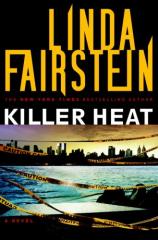Reading Group Guide
Discussion Questions
Killer Heat

1. What are Alex and Mike able to learn about the killer and the victim from the crime scene depicted in the opening chapter? How did your hunches and theories change as the evidence continued to build?
2. What did Kerry Hastings’s experience reveal about the history of prosecuting rapists in America? What cultural shifts had to take place in order for changes to be enacted, such as the broad inclusion of women on juries and an abolishment of a statute of limitations for rape? What would it take to bring about change in countries where rape victims are now treated as criminals?
3. How did Alex’s perception of Herb Ackerman change after he revealed his fetish? Which revelations about Amber were useful in finding her killer? What interrogation techniques does Alex rely on to ensure that witnesses are not only trustworthy but also trial-worthy?
4. With or without DNA evidence, how would you have reacted to the behavior of the Latin Princes if you had been a juror during Floyd Warren’s twenty-first-century trial?
5. Alex often has to confront rivalries between D.A.s and between law enforcement officials with varying jurisdictions. Do these rivalries spark healthy competition, or are they obstacles to justice?
6. In chapter twenty-three, Dickie Draper tries to profile the killer: “Eighteen to thirty-five, tops. Takes a lot of energy to do this. … Mostly a white boy’s game. … And they’re never Jewish.” How useful were his assumptions? What distinguishes between effective and ineffective profiling?
7. How does it affect your reading to know that the author ran the Sex Crimes Unit in the Manhattan District Attorney’s Office for more than two decades? How does her experience shape the realism of her books?
8. What makes Luc the ideal match for Alex at this point in her life? How has her profession influenced her love life in previous novels?
9. What does Troy Rasheed’s story indicate about the nature of evil? Was his mindset influenced more by his childhood or by his innate nature?
10. How did you react to Nelly Kallin’s closing line in chapter thirty-eight: “It’s not these bastards’ gonads that drive them to assault their victims, detective. It’s their twisted heads”? Did Troy’s history change your opinions about pharmaceutical “castration”? What is the best way to protect society from such criminals? Should Troy and Floyd be grouped in the same sexual-predator category?
11. Like Kiernan, did you believe that Jimmy Dylan was involved in the murders? How did your perception of the Dylan family shift throughout the novel? How much background screening should a bar be required to do before offering a job to a bouncer?
12. What kept Alex alive during her brutal confrontation with Troy, despite the booby traps he had set, as well as her severe claustrophobia? Could any sort of training or mental conditioning have kept Amber, Elise, Connie, and Pam from being captured by him? What do the victims’ diverse backgrounds indicate about the combined randomness and precision in violent criminals?
13. What did you discover about Alex when she was receiving her weapons training? What does her trouble with guns indicate about the major differences between her and Mike? Do her affluent background and her love for ballet and Parisian sojourns make it easier or harder for her to connect with the gritty realities of their casework?
14. In what way does New York itself play a role in the plot of Killer Heat, with references to landmarks ranging from the legendary restaurant Lutèce to the sprawling historic buildings of Governors Island? What did you discover about the military history of New York state through Alex’s dispatches to West Point and Governors Island?
15. What transformations have occurred in Alex since her debut in Final Jeopardy? How have her working relationships with Mike and Mercer been enhanced over the years?








